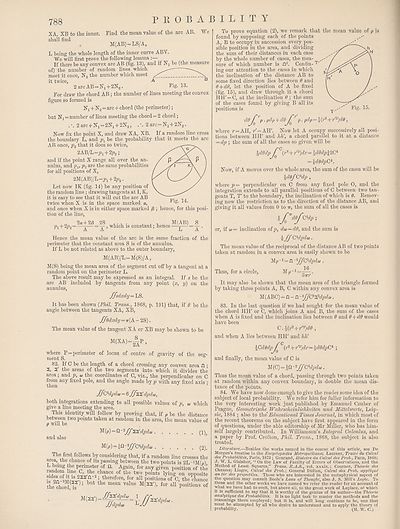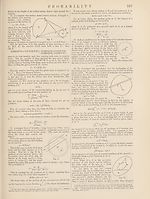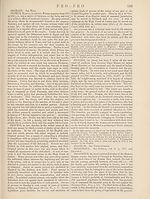Encyclopaedia Britannica > Volume 19, PHY-PRO
(798) Page 788
Download files
Complete book:
Individual page:
Thumbnail gallery: Grid view | List view

788
PROBABILITY
XA, XB to the inner,
shall find
Find the mean value of the arc AB.
M(AB) = LS/A,
We
L being the whole length of the inner curve ABY.
We will first prove the following lemma : .
If there be any convex arc AB (fig. 13), and if Xj be (the measure
of) the number of random lines which
meet it once, N2 the number which meet
it twice,
2 arc AB^XiA 2X2 . Fig. 13.
For draw the chord AB; the number of lines meeting the convex
figure so formed is
Xi + X2 = arc + chord (the perimeter);
but X1=number of lines meeting the chord = 2 chord;
.*. 2 arc + X1 = 2X1 + 2X2, .\ 2arc = X1 + 2X2.
Xow fix the point X, and draw XA, XB. If a random line cross
the boundary L, and y>1 be the probability that it meets the arc
AB once, y>2 that it does so twice,
2AB/L =jpx + 2^2;
and if the point X range all over the an¬
nulus, and •px, p2 are the same probabilities
for all positions of X,
2M(AB)/L =px + 2p2 .
Let now IK (fig. 14) be any position of
the random line ; drawing tangents at I, K,
it is easy to see that it will cut the arc AB
twice when X is in the space marked a,
and once when X is in either space marked ; hence, for this posi¬
tion of the line,
, 0 2a + 20 2S , . , . , , , M(AB)
2h + 2jo2 = —r— = -j-, which is constant; hence —~
A •
Hence the mean value of the arc is the same fraction of the
perimeter that the constant area S is of the annulus.
If L be not related as above to the outer boundary,
M(AB)/L = M(S)/A,
M(S) being the mean area of the segment cut off by a tangent at a
random point on the perimeter L.
The above result may be expressed as an integral. If s be the
arc AB included by tangents from any point (x, y) on the
annulus,
ffsdxdy = LS.
It has been shown {Phil. Trans., 1868, p. 191) that, if 6 be the
angle between the tangents XA, XB,
JJ'dclxdy=7r(A - 2S).
The mean value of the tangent XA or XB may be shown to be
M(XA) = ^P,
where P = perimeter of locus of centre of gravity of the seg¬
ment S.
82. If C be the length of a chord crossing any convex area n ;
2, 2' the areas of the two segments into which it divides the
area; and p, o> the coordinates of C, viz., the perpendicular on C
from any fixed pole, and the angle made by p with any fixed axis •
then
ffCHpdu = 6 ff'Z'Z'dpdw,
both integrations extending to all possible values of p, w which
give a line meeting the area.
This identity will follow by proving that, if P be the distance
between two points taken at random in the area, the mean value of
p will be
M(p) = fi-2j/^'22'c(p^w (I)j
and also
M(p) = JO -Wdpda)
(2)
The first foilows by considering that, if a random line crosses tin
area, tfie chance of its passing between the two points is 2L-1M(o)
L being the perimeter of If. Again, for any given position of tin
landom line C, the chance of the two points lying on opposit.
To prove equation (2), we remark that the mean value of p is
found by supposing each of the points
A, B to occupy in succession every pos¬
sible position in the area, and dividing
the sum of their distances in each case
by the whole number of cases, the mea- ,
sure of which number is n2. Confin- T'
ing our attention to the cases in which
the inclination of the distance AB to
some fixed direction lies between 6 and
6 +d9, let the position of A be fixed
(fig. 15), and draw through it a chord
HH' ■= C, at the inclination 0 ; the sum
of the cases found by giving B all its
positions is
doj^' p . pdp + doj^' p. pdp = l {7'3 + r'3)d0,
where r = AH, r' = AH'. Xow let A occupy successively all posi¬
tions between HH' and hh', a chord parallel to it at a distance
= dp ; the sum of all the cases so given will be
\dOdp f {r3 + r'3)dr = \d0dp\2Gi
^^dQdpC*.
Xow, if A moves over the whole area, the sum of the cases will be
^dof C^dp ,
where p= perpendicular on C from any fixed pole 0, and the
integration extends to all parallel positions of C between two tan¬
gents T, T' to the boundary, the inclination of which is 0. Remov¬
ing now the restriction as to the direction of the distance AB, and
giving it all values from 0 to tt, the sum of all the cases is
or, if &>= inclination of^, doi^dO, and the sum is
i If ^dpdu.
The mean value of the reciprocal of the distance AB of two points
taken at random in a convex area is easily shown to be
Wp-^n-y/CHpdu.
Thus, for a circle, M p *1 = -I.
ottV
It may also be shown that the mean area of the triangle formed
by taking three points A, B, C within any convex area is
M(ABC) = n-n --iffc^hlpdoo.
83. In the last question if we had sought for the mean value of
the chord HH' or C, which joins A and B, the sum of the cases
when A is fixed and the inclination lies between 6 and 6 + d0 would
have been
C. ^{r2 + r,f2)d0 ,
and when A lies between HH' and hh'
iCdddp^ V2 + r'2)dr=\d6dpCi ;
and finally, the mean value of C is
M (C) = - 2Jf C^dpdto.
Thus the mean value of a chord, passing through two points taken
at random within any convex boundary, is double the mean dis¬
tance of the points.
84. We have now done enough to give the reader some idea of the
subject of local probability. We refer him for fuller information to
the very interesting work just published by Emanuel Czuber of
Prague, Geometrische Wahrscheinlichkeiten und Mittelwerte, Leip-
sic, 1884 ; also to the’ Educational Times Journal, in which most of
the recent theorems on the subject have first appeared in the form
of questions, under the able editorship of Mr Miller, who has him¬
self largely contributed. In Williamson’s Integral Calculus, and
a paper by Prof. Crofton, Phil. Trails., 1868, the subject is also
treated.
Literature.—Besides the works named in the course of this article, see De
Morgan’s treatise in the Encyclopxdia Metropolitana-, Laurent, Traite du Calcul
des Probabilites, Paris, 1873 ; Gourand, Jiistoire du Calcul des Prob., Paris, 1848;
J. W. L. Glaisher, “On the Law of Facility of Errors of Observations, and the
Method of Least Squares,” Trans. P.A.S., vol. xxxix.; Cournot, Theorie des
Chances-, Liagre, Calcul des Prob.-, General Didion, Calcul des Prob. applique
au tir des projectiles. Those who are interested in the metaphysical aspect of
the question may consult Boole’s Laws of Thought, also J. S. Mill’s Logic. To
these and the other works we have named we refer the reader for an account of
what we have had to omit, but above all, to the great work of Laplace, of which
it is sufficient to say that it is worthy of the genius of its author—the Theorie
analytique des Probabilites. It is no light task to master the methods and the
reasonings there employed; but it is, and will long continue to be, one that
must be attempted by all who desire to understand and to apply the theory of
probability. (M. W. C.)
PROBABILITY
XA, XB to the inner,
shall find
Find the mean value of the arc AB.
M(AB) = LS/A,
We
L being the whole length of the inner curve ABY.
We will first prove the following lemma : .
If there be any convex arc AB (fig. 13), and if Xj be (the measure
of) the number of random lines which
meet it once, N2 the number which meet
it twice,
2 arc AB^XiA 2X2 . Fig. 13.
For draw the chord AB; the number of lines meeting the convex
figure so formed is
Xi + X2 = arc + chord (the perimeter);
but X1=number of lines meeting the chord = 2 chord;
.*. 2 arc + X1 = 2X1 + 2X2, .\ 2arc = X1 + 2X2.
Xow fix the point X, and draw XA, XB. If a random line cross
the boundary L, and y>1 be the probability that it meets the arc
AB once, y>2 that it does so twice,
2AB/L =jpx + 2^2;
and if the point X range all over the an¬
nulus, and •px, p2 are the same probabilities
for all positions of X,
2M(AB)/L =px + 2p2 .
Let now IK (fig. 14) be any position of
the random line ; drawing tangents at I, K,
it is easy to see that it will cut the arc AB
twice when X is in the space marked a,
and once when X is in either space marked ; hence, for this posi¬
tion of the line,
, 0 2a + 20 2S , . , . , , , M(AB)
2h + 2jo2 = —r— = -j-, which is constant; hence —~
A •
Hence the mean value of the arc is the same fraction of the
perimeter that the constant area S is of the annulus.
If L be not related as above to the outer boundary,
M(AB)/L = M(S)/A,
M(S) being the mean area of the segment cut off by a tangent at a
random point on the perimeter L.
The above result may be expressed as an integral. If s be the
arc AB included by tangents from any point (x, y) on the
annulus,
ffsdxdy = LS.
It has been shown {Phil. Trans., 1868, p. 191) that, if 6 be the
angle between the tangents XA, XB,
JJ'dclxdy=7r(A - 2S).
The mean value of the tangent XA or XB may be shown to be
M(XA) = ^P,
where P = perimeter of locus of centre of gravity of the seg¬
ment S.
82. If C be the length of a chord crossing any convex area n ;
2, 2' the areas of the two segments into which it divides the
area; and p, o> the coordinates of C, viz., the perpendicular on C
from any fixed pole, and the angle made by p with any fixed axis •
then
ffCHpdu = 6 ff'Z'Z'dpdw,
both integrations extending to all possible values of p, w which
give a line meeting the area.
This identity will follow by proving that, if P be the distance
between two points taken at random in the area, the mean value of
p will be
M(p) = fi-2j/^'22'c(p^w (I)j
and also
M(p) = JO -Wdpda)
(2)
The first foilows by considering that, if a random line crosses tin
area, tfie chance of its passing between the two points is 2L-1M(o)
L being the perimeter of If. Again, for any given position of tin
landom line C, the chance of the two points lying on opposit.
To prove equation (2), we remark that the mean value of p is
found by supposing each of the points
A, B to occupy in succession every pos¬
sible position in the area, and dividing
the sum of their distances in each case
by the whole number of cases, the mea- ,
sure of which number is n2. Confin- T'
ing our attention to the cases in which
the inclination of the distance AB to
some fixed direction lies between 6 and
6 +d9, let the position of A be fixed
(fig. 15), and draw through it a chord
HH' ■= C, at the inclination 0 ; the sum
of the cases found by giving B all its
positions is
doj^' p . pdp + doj^' p. pdp = l {7'3 + r'3)d0,
where r = AH, r' = AH'. Xow let A occupy successively all posi¬
tions between HH' and hh', a chord parallel to it at a distance
= dp ; the sum of all the cases so given will be
\dOdp f {r3 + r'3)dr = \d0dp\2Gi
^^dQdpC*.
Xow, if A moves over the whole area, the sum of the cases will be
^dof C^dp ,
where p= perpendicular on C from any fixed pole 0, and the
integration extends to all parallel positions of C between two tan¬
gents T, T' to the boundary, the inclination of which is 0. Remov¬
ing now the restriction as to the direction of the distance AB, and
giving it all values from 0 to tt, the sum of all the cases is
or, if &>= inclination of^, doi^dO, and the sum is
i If ^dpdu.
The mean value of the reciprocal of the distance AB of two points
taken at random in a convex area is easily shown to be
Wp-^n-y/CHpdu.
Thus, for a circle, M p *1 = -I.
ottV
It may also be shown that the mean area of the triangle formed
by taking three points A, B, C within any convex area is
M(ABC) = n-n --iffc^hlpdoo.
83. In the last question if we had sought for the mean value of
the chord HH' or C, which joins A and B, the sum of the cases
when A is fixed and the inclination lies between 6 and 6 + d0 would
have been
C. ^{r2 + r,f2)d0 ,
and when A lies between HH' and hh'
iCdddp^ V2 + r'2)dr=\d6dpCi ;
and finally, the mean value of C is
M (C) = - 2Jf C^dpdto.
Thus the mean value of a chord, passing through two points taken
at random within any convex boundary, is double the mean dis¬
tance of the points.
84. We have now done enough to give the reader some idea of the
subject of local probability. We refer him for fuller information to
the very interesting work just published by Emanuel Czuber of
Prague, Geometrische Wahrscheinlichkeiten und Mittelwerte, Leip-
sic, 1884 ; also to the’ Educational Times Journal, in which most of
the recent theorems on the subject have first appeared in the form
of questions, under the able editorship of Mr Miller, who has him¬
self largely contributed. In Williamson’s Integral Calculus, and
a paper by Prof. Crofton, Phil. Trails., 1868, the subject is also
treated.
Literature.—Besides the works named in the course of this article, see De
Morgan’s treatise in the Encyclopxdia Metropolitana-, Laurent, Traite du Calcul
des Probabilites, Paris, 1873 ; Gourand, Jiistoire du Calcul des Prob., Paris, 1848;
J. W. L. Glaisher, “On the Law of Facility of Errors of Observations, and the
Method of Least Squares,” Trans. P.A.S., vol. xxxix.; Cournot, Theorie des
Chances-, Liagre, Calcul des Prob.-, General Didion, Calcul des Prob. applique
au tir des projectiles. Those who are interested in the metaphysical aspect of
the question may consult Boole’s Laws of Thought, also J. S. Mill’s Logic. To
these and the other works we have named we refer the reader for an account of
what we have had to omit, but above all, to the great work of Laplace, of which
it is sufficient to say that it is worthy of the genius of its author—the Theorie
analytique des Probabilites. It is no light task to master the methods and the
reasonings there employed; but it is, and will long continue to be, one that
must be attempted by all who desire to understand and to apply the theory of
probability. (M. W. C.)
Set display mode to:
![]() Universal Viewer |
Universal Viewer | ![]() Mirador |
Large image | Transcription
Mirador |
Large image | Transcription
Images and transcriptions on this page, including medium image downloads, may be used under the Creative Commons Attribution 4.0 International Licence unless otherwise stated. ![]()
| Encyclopaedia Britannica > Encyclopaedia Britannica > Volume 19, PHY-PRO > (798) Page 788 |
|---|
| Permanent URL | https://digital.nls.uk/194084329 |
|---|
| Attribution and copyright: |
|
|---|---|
| Shelfmark | EB.17 |
|---|---|
| Description | Ten editions of 'Encyclopaedia Britannica', issued from 1768-1903, in 231 volumes. Originally issued in 100 weekly parts (3 volumes) between 1768 and 1771 by publishers: Colin Macfarquhar and Andrew Bell (Edinburgh); editor: William Smellie: engraver: Andrew Bell. Expanded editions in the 19th century featured more volumes and contributions from leading experts in their fields. Managed and published in Edinburgh up to the 9th edition (25 volumes, from 1875-1889); the 10th edition (1902-1903) re-issued the 9th edition, with 11 supplementary volumes. |
|---|---|
| Additional NLS resources: |
|

